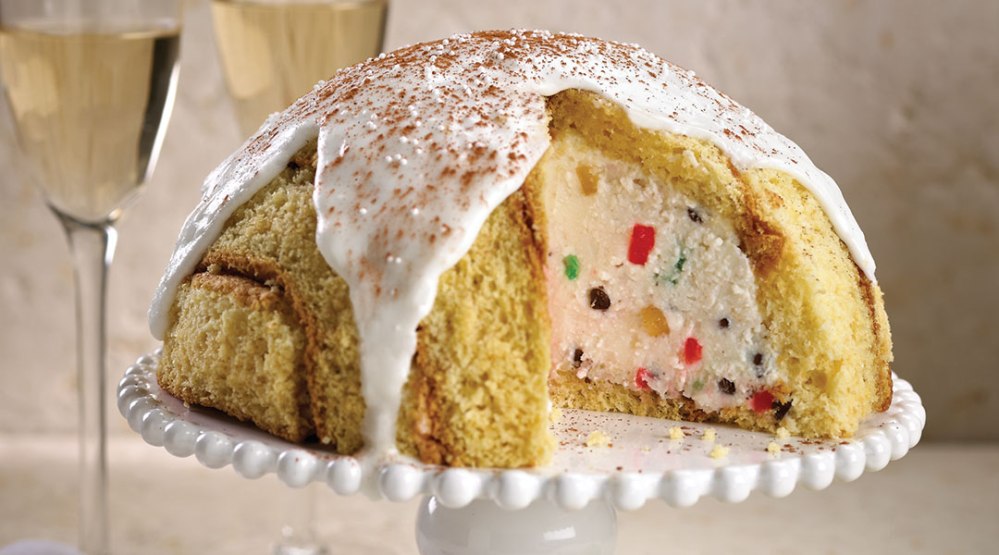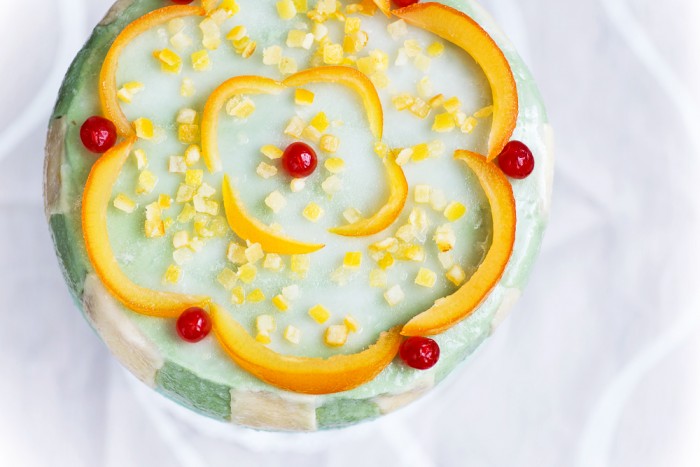This ricotta-filled Easter tradition is one of the most interesting food tales you would have ever heard.
According to historian Clifford Wright, in A Mediterranean Feast, “Cassata is a lavish cake from Sicily – a liqueur-soaked sponge cake interspersed with ricotta cheese.”
Among pastry chefs who grew up eating Cassata in Italy or in the United States, it is agreed that a cake called the Cassata Siciliana is prepared in a pan with sloping sides, and decorated with a ring of green marzipan and candied fruits. But its origins and variations are a debate even more colorful than the dessert itself.

Just about every source you would find would say that there is a link between cassata and the Arab invasion of Sicily in the 10th century. It is said that it was the Arabs who brought the tradition of sugar production to Italy. Many even suggest that the word cassata could have its roots in the Latin word for cheese – caseus.
But Cassata, more than anything else, is born out of fascination with sugar, not cheese. Plus, sugar was not cultivated or produced in Sicily during the Roman era. So, it wasn’t until the Arabs arrived that sugar took hold in Sicily and that quite supports the argument that the cake’s name comes from the Arabic word for a wide circular pan with sloping sides – qas’at – the type of dish a cassata is traditionally made in.
However, there are equal number of people who support the theory of its Latin origins.

That apart, everyone agrees Easter is Cassata’s grand moment. Documents show the cake was made by both nuns for Easter and Sicilian Jews for Purim; they called it cassati. It is believed that when Arabs occupied Sicily they brought their sugar-making traditions and merged them with the pastry-making that was happening in convents. Cassata was so delicious and seductive that as late as 1574, the Diocese of Mazara del Vallo had to prohibit its making at the monastery during the Holy Week because the nuns preferred to bake and eat it than pray.
The cake is believed to have originated in or around Palermo, where sheep’s milk ricotta, pistachios, and citrus were prevalent. The Arab occupation could also explain why candied fruit often graces the top of the cake in a baroque or, some say, Arabian pattern.

But no matter which theory you support, never call it a Cassata cake. That would be a criminal offense. There are two cassatas: cassata al forno is like the country bumpkin, a simple ricotta filling, sometimes studded with chocolate, baked inside a pastafrola crust. Pastafrola is Italy’s answer to pie dough; it’s typically sweetened and enriched with egg.
This is still a commonly made version, sometimes found in pastry shops, but more often baked at home. Civitello notes that the al forno version could have been the original, but as pastry-making and sugar production evolved in Sicily, and as overall wealth increased, people could afford to use fresh ricotta and dress their cakes with more bells and whistles.

To make the most popular version of cassata Siciliana, a thin layer of marzipan tinted green is pushed up against the sides of a plastic-wrap-lined metal pan with sloping sides. Some say the marzipan border should be striped vertically in green and white. Then, slices of pre-baked sponge cake known as pan de espana are fit tightly into the bottom. The cake is brushed with a sugar syrup sometimes spiked with maraschino liqueur, marsala, or rum. The center is filled with a thick layer of sweetened ricotta cheese that can be flavored with orange zest; sometimes chocolate bits are folded into the cream, too. Another layer of sponge cake caps the cake, and it’s wrapped tightly in plastic film and sometimes weighted down slightly before sitting overnight in the refrigerator. (It is not baked.) The next day, it’s inverted and unmolded. The top is covered with a soft white fondant, or sugar paste. It’s then decorated with candied fruits. Traditionally, a candied mandarin goes in the center with slices of candied squash forming petals around it, and candied pear, citron and cherries lining the perimeter. Some bakeries also opt to gild the lily with royal icing atop the fruit and on the sides.

Cassata was traditionally only served once a year precisely because of its cost: Making it is a multi-day affair, and between the labor-intensive ricotta, nuts for the marzipan, fondant, and candied fruit, even by today’s standards, it’s a very expensive cake.
There are as many types of cassata in Italy as there are types of American pie. Cassata al forno, the one baked in a pastry crust, can be made with a ricotta custard thickened with a grain like barley, flavored with bits of candied fruit, or studded with nuts or chocolate. Some Italians call a sponge cake filled and iced with ricotta cream — sans marzipan and with or without candied fruit decorations — cassata. (Others call that a torta di ricotta.) In some parts of Sicily, individually-sized cakes called cassatella di Sant’Agata are the norm. The small dome shape is completely covered with marzipan and topped with a single candied cherry. It’s meant to mimic the shape of St. Agata’s breast, an allusion to the torture — her breasts were amputated — the saint endured before her death.

Cassata Siciliana has inspired an ice cream cake of the same name, also decorated with candied fruit, but layered and served frozen. These recipes came with the Italians who immigrated to the U.S. at the turn of the 20th century, and their variations spawned a whole new variety of cassatas in the U.S., from versions spiked with chocolate and coffee to some — like the fruit-forward one popular in Cleveland — made without that otherwise key ingredient: ricotta. But to traditionalists, the ricotta is important. It should always be made with Ricotta.


Such a fascinating story! Ask most Indians and all they know about cassata is the ice cream!
LikeLike
Exactly. Nobody really knows what the original Sicilian Cassata is. Thanks.
LikeLiked by 1 person
I am not even aware of this being available in most bakery shops in India and even star hotels.
LikeLike
Its not mostly available in India.
LikeLiked by 1 person
Beautiful, what an interesting history. How have I never had this before?? Lovely photos also!
LikeLike
Thanks so much, really appreciate it. It is an amazing dessert.
LikeLiked by 1 person
Reblogged this on blackbeautyandme.
LikeLike